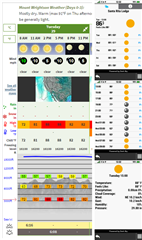Hi,
I used the weather report of in reach Mini and this report is useless for mountaineers.
The weather report bases on DarkSky and they have only some reference stations. The current altitude is not part of the forecast, wind direction or wind speed is completely wrong if you are
in height of 2000 - 3000 meters because the weather forecast station is normally the next city (normally in the valley).
Sorry Garmin. Its not really a professional device for longer outdoor trips in the mountains.
Best regards
Florian



